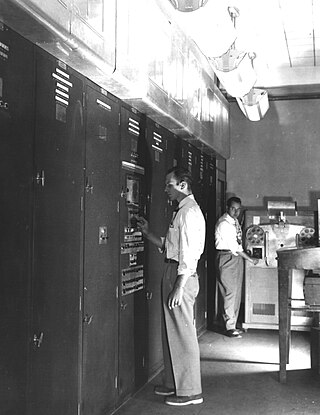
EDVAC was one of the earliest electronic computers. It was built by Moore School of Electrical Engineering, Pennsylvania. Along with ORDVAC, it was a successor to the ENIAC. Unlike ENIAC, it was binary rather than decimal, and was designed to be a stored-program computer.

The IBM 1620 was announced by IBM on October 21, 1959, and marketed as an inexpensive scientific computer. After a total production of about two thousand machines, it was withdrawn on November 19, 1970. Modified versions of the 1620 were used as the CPU of the IBM 1710 and IBM 1720 Industrial Process Control Systems.

The IBM 650 Magnetic Drum Data-Processing Machine is an early digital computer produced by IBM in the mid-1950s. It was the first mass-produced computer in the world. Almost 2,000 systems were produced, the last in 1962, and it was the first computer to make a meaningful profit. The first one was installed in late 1954 and it was the most popular computer of the 1950s.

BARK was an early electromechanical computer. BARK was built using standard telephone relays, implementing a 32-bit binary machine. It could perform addition in 150 ms and multiplication in 250 ms. It had a memory with 50 registers and 100 constants. It was later expanded to double the memory. Howard Aiken stated in reference to BARK "This is the first computer I have seen outside Harvard that actually works."
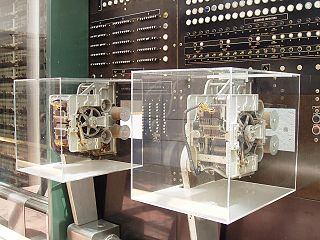
The Harvard Mark I, or IBM Automatic Sequence Controlled Calculator (ASCC), was one of the earliest general-purpose electromechanical computers used in the war effort during the last part of World War II.
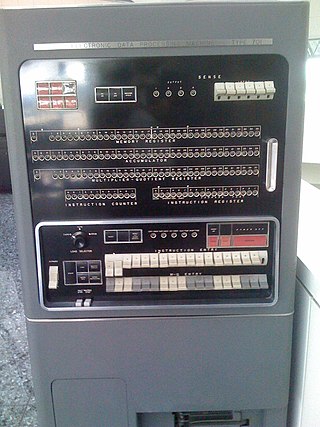
The IBM 701 Electronic Data Processing Machine, known as the Defense Calculator while in development, was IBM’s first commercial scientific computer and its first series production mainframe computer, which was announced to the public on May 21, 1952. It was designed and developed by Jerrier Haddad and Nathaniel Rochester and was based on the IAS machine at Princeton.
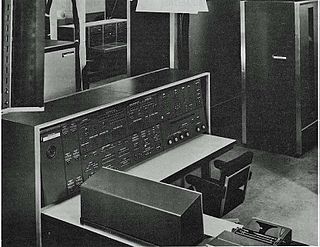
The UNIVAC LARC, short for the Livermore Advanced Research Computer, is a mainframe computer designed to a requirement published by Edward Teller in order to run hydrodynamic simulations for nuclear weapon design. It was one of the earliest supercomputers.
The First Draft of a Report on the EDVAC is an incomplete 101-page document written by John von Neumann and distributed on June 30, 1945 by Herman Goldstine, security officer on the classified ENIAC project. It contains the first published description of the logical design of a computer using the stored-program concept, which has come to be known as the von Neumann architecture; the name has become controversial due to von Neumann's failure to name other contributors.
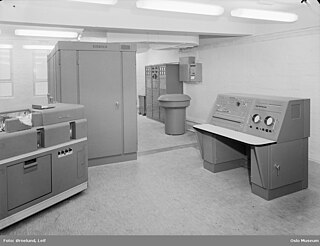
The DEUCE was one of the earliest British commercially available computers, built by English Electric from 1955. It was the production version of the Pilot ACE, itself a cut-down version of Alan Turing's ACE.

The Bendix G-15 is a computer introduced in 1956 by the Bendix Corporation, Computer Division, Los Angeles, California. It is about 5 by 3 by 3 feet and weighs about 966 pounds (438 kg). The G-15 has a drum memory of 2,160 29-bit words, along with 20 words used for special purposes and rapid-access storage. The base system, without peripherals, cost $49,500. A working model cost around $60,000. It could also be rented for $1,485 per month. It was meant for scientific and industrial markets. The series was gradually discontinued when Control Data Corporation took over the Bendix computer division in 1963.
The UNIVAC 418 was a transistorized, 18-bit word magnetic-core memory machine made by Sperry Univac. The name came from its 4-microsecond memory cycle time and 18-bit word. The assembly language for this class of computers was TRIM III and ART418.

The IBM Selective Sequence Electronic Calculator (SSEC) was an electromechanical computer built by IBM. Its design was started in late 1944 and it operated from January 1948 to August 1952. It had many of the features of a stored-program computer, and was the first operational machine able to treat its instructions as data, but it was not fully electronic. Although the SSEC proved useful for several high-profile applications, it soon became obsolete. As the last large electromechanical computer ever built, its greatest success was the publicity it provided for IBM.
ADEC or ADeC may refer to:
The Harvard Mark II, also known as the Aiken Relay Calculator, was an electromechanical computer built under the direction of Howard Aiken at Harvard University, completed in 1947. It was financed by the United States Navy and used for ballistic calculations at Naval Proving Ground Dahlgren. Computer pioneers Edmund Berkeley and Grace Hopper worked together under Aiken to build and program the Mark II

The Olivetti Programma 101, also known as Perottina or P101, is one of the first "all in one" commercial desktop programmable calculators, although not the first. Produced by Italian manufacturer Olivetti, based in Ivrea, Piedmont, and invented by the Italian engineer Pier Giorgio Perotto, the P101 used many features of large computers of that period. It was launched at the 1964 New York World's Fair; volume production started in 1965. A futuristic design for its time, the Programma 101 was priced at $3,200 (equivalent to $30,900 in 2023). About 44,000 units were sold, primarily in the US.
Ferranti's Sirius was a minicomputer released in 1961. Designed to be used in smaller offices without a dedicated programming staff, the Sirius used decimal arithmetic instead of binary, supported Autocode to ease programming, was designed to fit behind a standard office desk, and ran on UK standard mains electricity with no need for cooling. It was also fairly slow, with instruction speeds around 4,000 operations per second, and had limited main memory based on delay lines, but as Ferranti pointed out, its price/performance ratio was difficult to beat.

The IBM Naval Ordnance Research Calculator (NORC) was a one-of-a-kind first-generation computer built by IBM for the United States Navy's Bureau of Ordnance. It went into service in December 1954 and was likely the most powerful computer at the time. The Naval Ordnance Research Calculator (NORC), was built at the Watson Scientific Computing Laboratory under the direction of Wallace Eckert.

A vacuum-tube computer, now termed a first-generation computer, is a computer that uses vacuum tubes for logic circuitry. While the history of mechanical aids to computation goes back centuries, if not millennia, the history of vacuum tube computers is confined to the middle of the 20th century. Lee De Forest invented the triode in 1906. The first example of using vacuum tubes for computation, the Atanasoff–Berry computer, was demonstrated in 1939. Vacuum-tube computers were initially one-of-a-kind designs, but commercial models were introduced in the 1950s and sold in volumes ranging from single digits to thousands of units. By the early 1960s vacuum tube computers were obsolete, superseded by second-generation transistorized computers.

The Monroe Calculating Machine Mark XI was a general-purpose stored-program electronic digital computer introduced in 1960 by the Monroe Calculating Machine Division of Litton Industries. The system was marketed for "primarily for billing, and invoice writing", but could also be used for low-end scientific computing.

The ERMETH (Electronic Calculating Machine of the ETH) was one of the first computers in Europe and was developed and built by Eduard Stiefel and his team of the Institute for Applied Mathematics at the ETH Zurich between 1948 and 1956. It was in use until 1963 and is now displayed at the Museum of Communication Bern (Switzerland).















